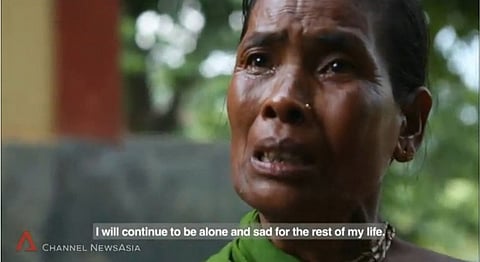
- #HGCREATORS
- #HGEXPLORE
- #HGVOICES
- #HGSHOP
- CAREERS
- ABOUT US
- CONTACT US

“The villagers believed if Kawe continued to live, she could cause more harm. So, they decided to kill her.” — There Timung, village head (translated to English).
48-year-old widow Kawe Ronghanpi hailed from the village Dhuidigaon in Assam’s Karbi Anglong district. We say ‘hailed’, past tense, because in July of 2015, she was lynched by other members of the village who accused her of performing black magic, calling her a witch, a carrier of evil. When a male member of Dhuidigaon fell suddenly ill, suffering from an unexplainable ailment, fingers were pointed towards Kawe, blaming her for cursing the ailing man. After she was killed, her daughter resisted seeking justice for her mother’s murder, fearing the wrath of the villagers involved.
A 15-year-old girl, who is the primary accused in Kawe’s murder and claims that Goddess Durga possessed her, shares in the documentary (translated to English), “Babu Keup. He was the main person who said, ‘Kill her soon.’ He said, ‘If you don’t kill her, then I will kill her myself.’ Then God killed her. That’s it.” Babu Keup is the brother of the man who fell unexplainably ill. As police investigations revealed, witnesses alleged that amidst the mob lunging to beat the ‘witch’, the juvenile strangled Kawe to death. Witch-Hunt Diaries, a documentary film produced by Channel News Asia’s investigative series titled Undercover Asia, aims to highlight “how a group of people with vested interests are able to use witchcraft & superstition to instigate a community to commit a brutal act of violence”.

According to the National Crime Records Bureau, 2,097 witch-hunt murders took place between 2000 and 2012 alone, with Jharkhand topping the list with 363 reported deaths. Assam’s number settles at over 130 witch-hunt murder since 2002, and what most states hosting this practice have in common is that most of the victims are women. Scholars, activists, academics and more have mused over the reason witch-hunts occur, pulling out cards ranging from superstition to healthcare inadequacies to caste-based discrimination and foul play.
“Mainly women are made scapegoats for all the evils of society such as famine, drought, or lack of water in the wells. The reasons behind these incidents range from a patriarchal mindset to illiteracy, superstition and lack of healthcare. Most often, it is about the denial of property rights to women. There are occasions, for instance, when people - especially widows - are targeted for their land and property,” explained Indira Jaising, a senior Supreme Court lawyer, in an interview with Deutsche Welle.
Shooting over five months in Assam’s insurgency belt, where even the local police hesitates to tread, the research and filming team worked without formal protection to reveal the socio-economic root causes of witch-hunts that journey beyond mere superstition. As the film’s lens travels to a neighbouring village, it brings out another side of witch-hunting practices, one that the alleged ‘witch’ herself equated to lifetime imprisonment. Raneshwari Rabha, whose step-daughter herself accused her of being a witch and spreading curses of illness, was socially boycotted and ostracised from her village, made to abandon her house and family. As the film alleges, the step-daughter’s motives point to property and land possession. “The villagers have warned my children that if I ever visit them, they will have to pay a fine of 1000 rupees,” Raneshwari shares in the documentary (translated to English). Rehabilitation of witch-hunt victims is scarce, banishing them to seclusion and isolation akin to a jail without bars.

“Poor, low-caste women are easy targets for naming/branding [as a witch]...Women who are widowed, infertile, possess ‘ugly’ features or are old, unprotected, poor or socially ostracised are easy targets,” stated Kanchan Mathur, a professor at the Institute of Development Studies. While legal intervention in the form of laws do exist in several states, such as the most recent Prevention of Witch-Hunting Bill, 2015 in Rajasthan, witch-hunt atrocities continue to infect minority village communities and tribal belts. With low conviction rates and challenging on-ground policing, this documentary brings into focus the dire human rights injustices labelled under the guise of witch-hunting.
Watch Witch-Hunt Diaries below, and read more about India’s witch-hunting practices here.
